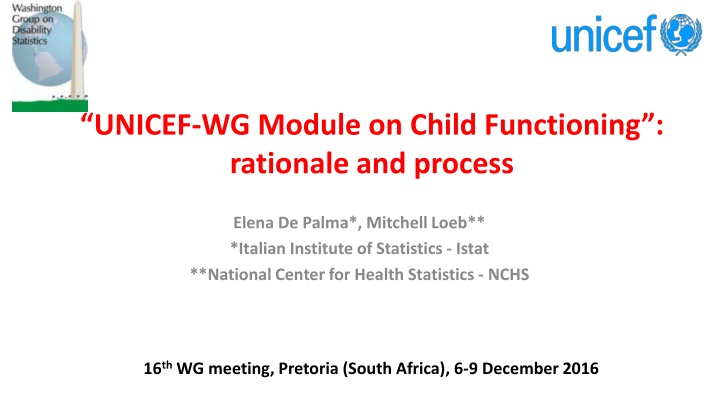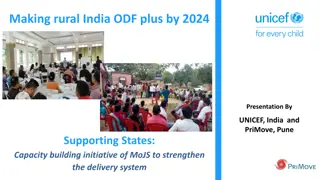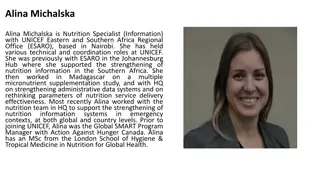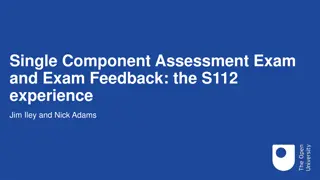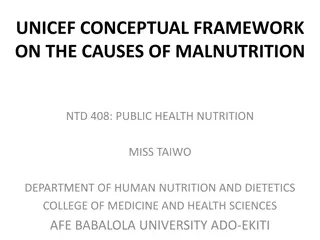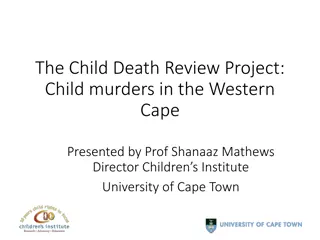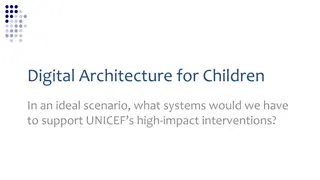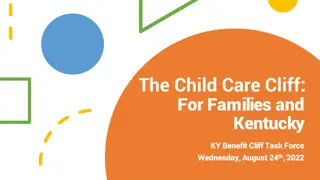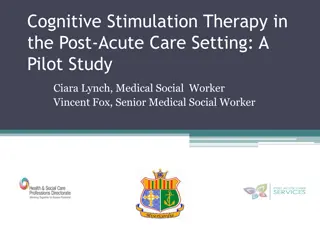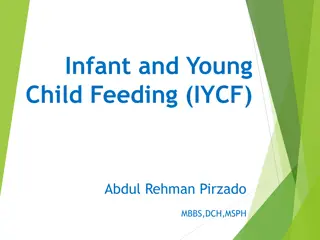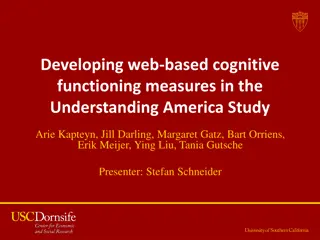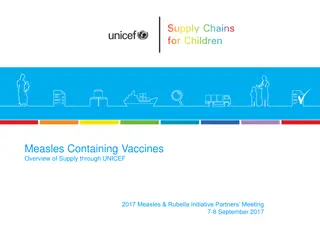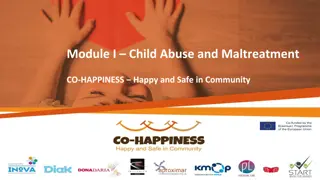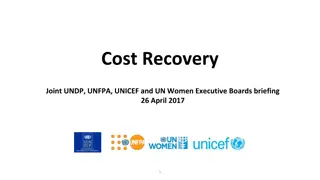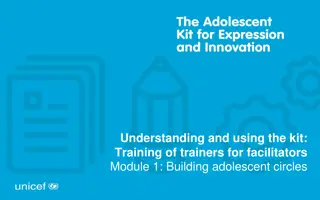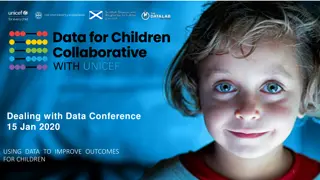UNICEF-WG Module on Child Functioning: Rationale and Process
Measuring child disability has become a priority following the adoption of the UNCRPD. This module aims to identify children with functional limitations and promote social participation. Developed in alignment with the ICF-CY, it ensures internationally comparable data on child functioning.
Download Presentation

Please find below an Image/Link to download the presentation.
The content on the website is provided AS IS for your information and personal use only. It may not be sold, licensed, or shared on other websites without obtaining consent from the author.If you encounter any issues during the download, it is possible that the publisher has removed the file from their server.
You are allowed to download the files provided on this website for personal or commercial use, subject to the condition that they are used lawfully. All files are the property of their respective owners.
The content on the website is provided AS IS for your information and personal use only. It may not be sold, licensed, or shared on other websites without obtaining consent from the author.
E N D
Presentation Transcript
UNICEF-WG Module on Child Functioning: rationale and process Elena De Palma*, Mitchell Loeb** *Italian Institute of Statistics - Istat **National Center for Health Statistics - NCHS 16thWG meeting, Pretoria (South Africa), 6-9 December 2016
Background (1) Since the adoption and enforcement of the United Nations Convention on the Rights of Persons with Disabilities (UNCRPD), measuring child disability has become a priority in the national and international arena Nevertheless, the quality and quantity of data available on child disability vary enormously across the World, and several factors undermine cross-national comparability of data As manifestations of disabilities in children and adolescents differ from those in adults, in order to measure child disability a standard set of questions must be developed in alignment with the ICF-CY classification of the specific aspects of child development and disability (WHO, 2007) 16thWG meeting, Pretoria (South Africa)
Background (2) At the end of 2009 a WG working group - composed of NSO representatives from both developed and developing countries - was established In 2011 UNICEF joined the working group To develop a survey module specifically designed to capture child functioning: - aligned with the ICF-CY - able to provide cross-nationally comparable data - usable as part of national population surveys or in addition to specific surveys (e.g. health, education etc. ) 16thWG meeting, Pretoria (South Africa)
The module Primary purpose: to identify the sub-population of children and youth with functional limitations in certain activities Rationale: in an unaccommodating environment, children with functional difficulties are at risk of experiencing limited social participation The ICF Model (WHO, 2001) Health Condition (disorder/disease Participation (Restriction) Body Function & Structure (Impairment) Activities (Limitation) Personal Factors Environmental Factors 16thWG meeting, Pretoria (South Africa)
In order to ensure that the set of questions will yield valid, reliable and internationally comparable results, the working group followed these main steps: Development of the Module: main steps Established guiding principles Reviewed literature Assessed existing questions/ tools Consulted child development specialists/ other survey methodologists Preparation Drafted/Revised the questions Conducted Multiple rounds of CTs Finalized the questions Conducted Field Tests Finalized the Module Established analytic properties Development & Validation Developed interviewer guidelines/user manual Carried out professional translations of the module Planned capacity building activities Fostering 16thWG meeting, Pretoria (South Africa)
Determination of the appropriate target population Despite the importance of early detection, child development itself makes it difficult to distinguish between significant functional limitations and variations in normal developmental process, especially in children under 2 years. As targeting children aged 0-2 is likely to produce inconsistent and ambiguous results, these were not included in the target population (2-17 years) Challenges Selection of feasible domains & production of a concise module Because child disability comprises a wide range of domains, some of which may require more than one question for an accurate assessment, there was the need to identify an essential set of domains. A review of the literature and a mapping of the questions in use vs. the ICF-CY checklists led to a parsimonious set of domains that reliably describe the main functional difficulties faced by children 16thWG meeting, Pretoria (South Africa)
Self vs. Proxy respondent Generally, disability measurement for children takes place through proxy. Even though this may introduce some bias, parents can actually facilitate the assessment of children over a wide age range. Considering the standard survey methodology, ethical considerations, children's ability to answer questions about their own difficulties in relation to their peers, and their health condition, it was decided to use parents/primary caregivers as proxy Challenges Steering proxy-respondents Parents rely on their observation and expectations for the child. Some questions were prefaced with: Compared with children of the same age in order to provide a point of reference in terms of child development in general and reduce the chance of the respondent making comparisons with children of other developmental stages 16thWG meeting, Pretoria (South Africa)
International comparability Children learn to perform actions at different speeds, influenced also by specific socio-cultural factors. So, while reviewing survey questions/tools actions applicable to all children regardless of nationality/culture were identified, with the help of child development experts Challenges Reduction of complexity To obtain precise information on functional limitations, questions must address actions that are specific to narrow age ranges, but to make the Module easier to administer, it was sought to balance accuracy and usability targeting actions applicable to wider age ranges: 2-4 and 5-17 years 16thWG meeting, Pretoria (South Africa)
Testing and validation, with involvement of different stakeholders, were carried out worldwide since 2012 by: Cognitive tests and Field Tests Validation of the Module The Questionnaire Design Research Laboratory of the US NCHS provided intensive training courses in each country for cognitive interviewers to ensure comparability of the data collected CTs were used to evaluate the cross-cultural equivalence of the Module, verifying that the questions were understood according to their intent, and are applicable to the widest range of respondents life contexts Cognitive test in the USA (2015) to evaluate the differences in how the same questions are interpreted/answered by teens and by their parent-proxy Field tests to gather information that could improve the implementation of the module by identifying data patterns in a population and challenges when using the module under field conditions 16thWG meeting, Pretoria (South Africa)
CT-based improvements Wording simplification Elimination of examples when inappropriate in some cultural contexts Elimination of the preface compared with children of the same age where this was deemed unnecessary and when question refers to less observable domains Adoption of the best wording when more options were tested Reduction of the number of questions to the minimum required to capture the population for each domain Inclusion of additional questions for some domains Modification of answer categories QDET2, Nov 9-13, 2016. Miami
Establishing analytic properties India: field test with medical follow-up 2-stage process: Stage 1: Administration of the module to a sample of parents of children aged 2-17 Stage 2: Clinical assessment (medical, vision, hearing, speech, motor, and psychological) of all children identified as having functional difficulties in stage 1. Sensitivity = 100% of children who were identified as having a lot of difficulty or cannot do at all in stage 1 were found to have an impairment in stage 2 Specificity = 99% of children who were identified as NOT having difficulty in stage 1 were found to be without disability in stage 2 16thWG meeting, Pretoria (South Africa)
Next Steps Release of the: a) UNICEF-WG Module on Child Functioning - early 2017 b) Interviewer guidelines - early 2017 Publication of field test results - end 2016 Finalisation of Manual for implementation - mid 2017 to provide background information on the development of the module, as well as technical information that will be useful for countries intending to implement it. UNICEF-WG workshops on child disability measurement across the world All 7 UNICEF regions (Latin America and the Caribbean, West and Central Africa, East and Southern Africa, Middle East and North Africa, CEE/CIS, East Asia and the Pacific, and South Asia). 16thWG meeting, Pretoria (South Africa)
The Module in a nutshell Objective: to identify the sub-population of children and youth (aged 2-17) with functional limitations who are at greater risk of experiencing limited social participation compared to children of the same age group Aim: to provide cross-nationally comparable data Domains: Seeing, Hearing, Walking, Communication, Learning, Playing, Relationships, Fine Motor, Behavior, Attention, Self-care, Emotions, Coping with change. Questions: aimed at parents/primary caregivers Answer categories: designed to reflect a continuum in functioning difficulties enabling the determination of appropriate cut-offs based on disability data collection requirements Usability: in national population surveys or as a supplement on specific topics of interest 16thWG meeting, Pretoria (South Africa)
Final remarks The UNICEF-WG Module on Child Functioning was developed in response to an internationally recognized need of comparable data It was built up with input from a variety of experts and stakeholders to be in line with the ICF and UNCRPD concept of disability It has undergone a series of cognitive and field tests that have proven the questions to be straightforward to administer and well understood by respondents across contexts and cultures It is a rigorous tested method of identification of children with disabilities in surveys. 16thWG meeting, Pretoria (South Africa)
References Crialesi R., De Palma E., Battisti A. (2016), Building a Module on Child Functioning and Disability in Altman M.B. (ed.) International Measurement of Disability: Purpose, Method and Application , Social Indicators Series n. 61, Springer. Massey M., Chepp V., Zablotsky B., Creamer C. (2014), Analysis of Cognitive Interview Testing of Child Disability Questions in Five Countries , NCHS, available at http://wwwn.cdc.gov/qbank/NewReports.aspx Massey M., Scanlon P., Lessem S., Cortes L., Villarroel M., Salvaggio M. (2015), Analysis of Cognitive Testing of Child Disability Questions: Parent-Proxy vs. Teen Self-Report , NCHS, available at http://wwwn.cdc.gov/qbank/NewReports.aspx For further information: Washington Group on Disability Statistics: http://www.washingtongroup-disability.com Mitchell Loeb (NCHS, WG): MLoeb@cdc.gov Elena De Palma (Istat, WG): depalma@istat.it 16thWG meeting, Pretoria (South Africa )
